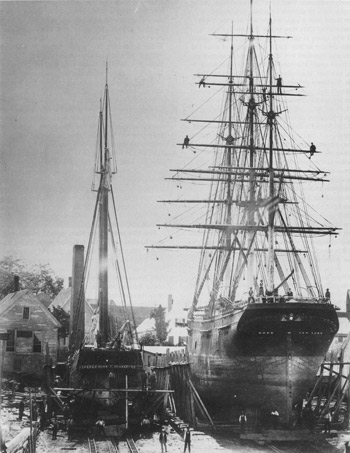B A C K T H E N
Schooner Alfred F. Howe and Ship Hope

Brewer, 1870. The schooner Alfred F. Howe of Searsport and the ship Hope of New York hauled out at William McGilvery & Company’s steam-powered marine railways. The facility was established in 1869. The Howe, built at Searsport in 1850 by John Carver, a master builder employed by William McGilvery, lasted until 1899. The Hope, built in 1862 at Bucksport by Sewall Swazey, was rebuilt in 1879, sold foreign in 1885, and in 1898 was sailing under the Chilean flag as the Cristina. She is hauled out for renewal of her metal sheathing, which protected her hull from shipworms.
The Hope was built at Bucksport for managing owner R. P. Buck & Company, a New York shipping firm headed by Bucksporter Richard P. Buck. McGilvery, a former Searsport shipmaster, with his brother Henry, engaged in shipbuilding in Belfast, Searsport, and Brewer. He was a managing owner of vessels, and a prominent Maine politician. In 1876, having invested unwisely in ventures of friends, he committed a sensational suicide.
McGilvery had strong ties of business and blood to the Buck family. His daughter Desiah married William Buck of the sawmill community of Bucksville, Horry County, South Carolina; his son, William, who predeceased him, died at Bucksville. Bucksville, far up the Waccamaw River, was founded by Henry Buck of Bucksport who, about 1830, was attracted by the region’s vast supply of superior white oak and hard pine ship timber. The hull of the bark Henry Buck, built in 1851 at Searsport for William McGilvery and Henry Buck, contained much hard pine to demonstrate that wood’s suitability for wider use in ship building.
The bark Fannie Buck, built at Searsport in 1853 for John McGilvery, was likely named for Henry Buck’s daughter, Frances. The bark Desiah, built at Searsport in 1863 for William McGilvery, was obviously named for McGilvery’s daughter and Henry Buck’s daughter-in-law. The ship Alice Buck, built at Belfast in 1870 by Captain Henry McGilvery, and managed by R. P. Buck & Company, was named for a daughter of William and Desiah McGilvery Buck.
At the outbreak of the Civil War, President Lincoln, a friend of McGilvery’s, sent a gunboat to fetch Desiah and her children. Although Buck was a large slave owner with two sons who fought for the Confederacy, he remained a strong Unionist. Immediately following Lee’s surrender a state of lawlessness prevailed in the region. Order was restored by Maine troops, whose posting likely reflected Buck’s influence. Major John M. Gould of the TwentyNinth Maine Regiment, a Portlander, wrote in his diary in January, 1866:
On my way back I passed by “Old Buck’s.” He is a State of Maine man and came up the Waccamaw a few years ago (20-odd) and saw the chances for enterprise .... He established himself there, created the village of Bucksville by building a house and marrying a southern gal. Then persuading the generous-hearted Uncle Samuel to make Bucksville a port of entry he imported and exported for the whole Waccamaw and PeeDee country or at least controlled the business and markets.
At the end of the war he set free six hundred Negroes and retained immense possessions of land, his mills, houses, and interest in three score or more vessels. He is now a little old, and having son, and sons-in-law, he lets them do the business which he established. I visited them and found them right clever fellows. [William] Buck Jr. had been to school in Gorham .... Wright (the son-in-law) had just returned from the Penobscot River with a gang of hands for the mill. All efforts he says to make his old Negroes work have proved fruitless, “There is no dependence to be placed upon them, they will work one day and be off frolicking the next.”
In 1873 Captain William McGilvery and a fellow Searsport shipbuilder, Captain Jonathan C. Nickels, sent a crew of shipbuilders to Bucksville to build the schooner Hattie McGilvery Buck, named after a daughter of William and Desiah Buck. Encouraged by the success of the experiment, McGilvery, Nickels, and Buck then recruited sixty-odd Penobscot Bay shipwrights to build a much larger vessel, the 1,266-ton ship Henrietta, launched at Bucksville in 1875. Elisha Dunbar, who managed McGilvery’s yard at Searsport, was master builder for both vessels. Although the Henrietta proved very satisfactory, she cost more than anticipated and had to be floated over the Winyah Bar assisted by a cradle of empty barrels. The experiment was not repeated.
While most of William Buck & Company’s postwarbusiness was evidently with the West Indies and South America, cargoes of hard pine from the Waccamaw continued to arrive in Maine, as well. The library at Bucksport, given to the town by R. P. Buck, is built with Waccamaw pine.
Text by William H. Bunting from A Days Work, Part 1, A Sampler of Historic Maine Photographs, 1860–1920, Part II. Published by Tilbury House Publishers, 12 Starr St., Thomaston, Maine. 800-582-1899.
